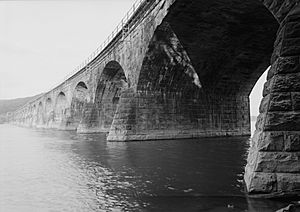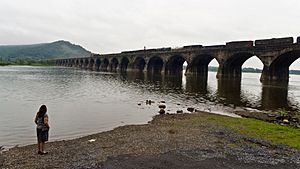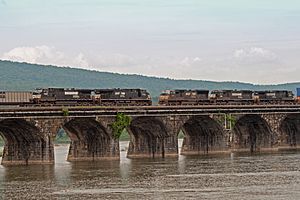Rockville Bridge facts for kids
Quick facts for kids Rockville Bridge |
|
|---|---|

Rockville Bridge in 1999
|
|
| Coordinates | 40°20′00″N 76°54′37″W / 40.3334°N 76.9103°W |
| Carries | 2 rail lines for Norfolk Southern Railway and Amtrak Pennsylvanian |
| Crosses | Susquehanna River |
| Locale | Just south of Marysville, Pennsylvania |
| Maintained by | Norfolk Southern Railway |
| Characteristics | |
| Design | Stone masonry arch bridge |
| Total length | 3,820 feet (1,164 m) |
| Width | 52 feet (16 m) |
| Longest span | 70 feet (21 m) (48 equal spans) |
| Clearance below | 43 feet (13 m) to avg. level of rock bottom |
| History | |
| Opened | March 30, 1902 |
|
Pennsylvania Historical Marker
|
|
| Designated: | April 29, 2010 |
The Rockville Bridge is a very long railroad bridge in Pennsylvania. When it was finished in 1902, it was the longest stone arch railroad bridge in the world. It is still the longest of its kind today!
This amazing bridge was built by the Pennsylvania Railroad. It took about two years to build, from April 1900 to March 1902. The bridge has 48 arches, and each arch spans 70 feet. The total length of the bridge is 3,820 feet (about 1,164 meters).
The Rockville Bridge crosses the Susquehanna River. It is located about 5 miles (8 km) north of Harrisburg, Pennsylvania. One end of the bridge is in a place called Rockville. The other end is near Marysville.
Building the Rockville Bridge
The first bridge in this spot opened a long time ago, on September 1, 1849. The Pennsylvania Railroad started using it then. Later, another railway company, the Northern Central Railway, also began to use it.
The current Rockville Bridge was built by many workers. Many of them were Italian laborers. They worked for two different construction companies. One company worked on the east side of the river, and the other worked on the west side. Local people from the Harrisburg area also helped build the bridge.
How the Bridge is Used Today
For most of its history, the Rockville Bridge had four main tracks for trains. In the 1980s, this was changed to three tracks. This happened when the Pennsylvania Railroad updated its main line across the state.
Today, the bridge is used by two important railway companies. These are the Norfolk Southern Railway and Amtrak. Amtrak runs passenger trains, while Norfolk Southern runs freight trains.
The Rockville Bridge is also a very important historical landmark. It was added to the National Register of Historic Places in 1975. This means it is recognized as a special place in history. In 1979, it was also named a National Historic Civil Engineering Landmark. This shows how important its design and construction were for engineering.



